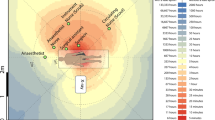Abstract
Purpose
This study was conducted to characterise the O-arm® surgical imaging system in terms of patient organ doses and medical staff occupational exposure during three-dimensional thoracic spine and pelvic examinations.
Methods
An anthropomorphic phantom was used to evaluate absorbed organ doses during a three-dimensional thoracic spine scan and a three-dimensional pelvic scan with the O-arm®. Staff occupational exposure was evaluated by constructing an ambient dose cartography of the operating theatre during a three-dimensional pelvic scan as well as using an anthropomorphic phantom to simulate the O-arm® operator.
Results
Patient organ doses ranged from 30 ± 4 μGy to 20.0 ± 3.0 mGy and 4 ± 1 μGy to 6.7 ± 1.0 mGy for a three-dimensional thoracic spine and pelvic examination, respectively. For a single three-dimensional acquisition, the maximum ambient equivalent dose at 2 m from the iso-centre was 11 ± 1 μSv.
Conclusion
Doses delivered to the patient during a three-dimensional thoracic spine image acquisition were found to be significant with the O-arm®, but lower than those observed with a standard computed tomography examination. The detailed dose cartography allows for the optimisation of medical staff positioning within the operating theatre while imaging with the O-arm®.




Similar content being viewed by others
References
Medtronic (2007) O-arm user manual, MN
Jin M, Liu Z, Liu X, Yan H, Han X, Qiu Y, Zhu Z (2015) Does intraoperative navigation improve the accuracy of pedicle screw placement in the apical region of dystrophic scoliosis secondary to neurofibromatosis type I: comparison between O-arm navigation and free-hand technique. Eur Spine J [Epub ahead of print]
Van de Kelft E, Costa F, Van der Planken D, Schils F (2012) A prospective multicenter registry on the accuracy of pedicle screw placement in the thoracic, lumbar and sacral level with the use of the O-arm imaging system and StealthStation navigation. Spine (Phila Pa 1976) 37:E1580–E1587
Beir VII (2006) Health risks from exposure to low levels of ionizing radiation, National Research Council of the National Academies, Washington D.C
Park MS, Lee KM, Lee B, Min E, Kim Y, Jeon S, Huh Y, Lee K (2012) Comparison of operator radiation exposure between C-arm and O-arm fluoroscopy for orthopaedic surgery. Radiat Prot Dosimetry 148:431–438
Lange J, Karellas A, Street J, Eck JC, Lapinsky A, Connolly PJ, Dipaola CP (2013) Estimating the effective radiation dose imparted by intraoperative cone-beam computed tomography in thoracolumbar spinal surgery. Spine (Phila Pa 1976) 38:E306–E312
Zhang J, Weir V, Fajardo L, Lin J, Hsiung H, Ritenour ER (2009) Dosimetric characterization of a cone-beam O-arm imaging system. J Xray Sci Technol 17:305–317
CIRS (2012) ATOM dosimetry phantoms, VA
ICRP (1975) Report on the task group on reference man. Publication 23, Ottawa
ICRU (1992) Phantoms and computational models in therapy, diagnosis and protection. Publication 48, MD
JCGM-W (2008) Guide to the expression of uncertainty in measurement. International Organization for Standardization, Geneva
APVL (2011) Manuel d’utilisation AT1123 V1. Saint-Cyr-sur-Loire, France
Hadelsberg UP, Harel R (2012) Hazards of ionizing radiation and its impact on spine surgery. World Neurosurg [Epub ahead of print]
Qureshi S, Lu Y, McAnany S, Baird E (2014) Three-dimensional intraoperative imaging modalities in orthopaedic surgery: a narrative review. J Am Acad Orthop Surg 22:800–809
Söderberg M, Abul-Kasim K, Ohlin A, Gunnarsson M (2011) Estimation of organ and effective dose to the patient during spinal surgery with a cone-beam O-arm system. Proc SPIE 7961:79613G1-G6
Zhang D, Li X, Gao Y, Xu X, Liu B (2013) A method to acquire CT organ dose map using OSL dosimeters and atom anthropomorphic phantoms. Med Phys 40:081918
ICRP (2007) Radiological protection in medicine. Publication 105, Ottawa
Author information
Authors and Affiliations
Corresponding author
Ethics declarations
Conflict of interest
None.
Rights and permissions
About this article
Cite this article
Pitteloud, N., Gamulin, A., Barea, C. et al. Radiation exposure using the O-arm® surgical imaging system. Eur Spine J 26, 651–657 (2017). https://doi.org/10.1007/s00586-016-4773-0
Received:
Revised:
Accepted:
Published:
Issue Date:
DOI: https://doi.org/10.1007/s00586-016-4773-0




